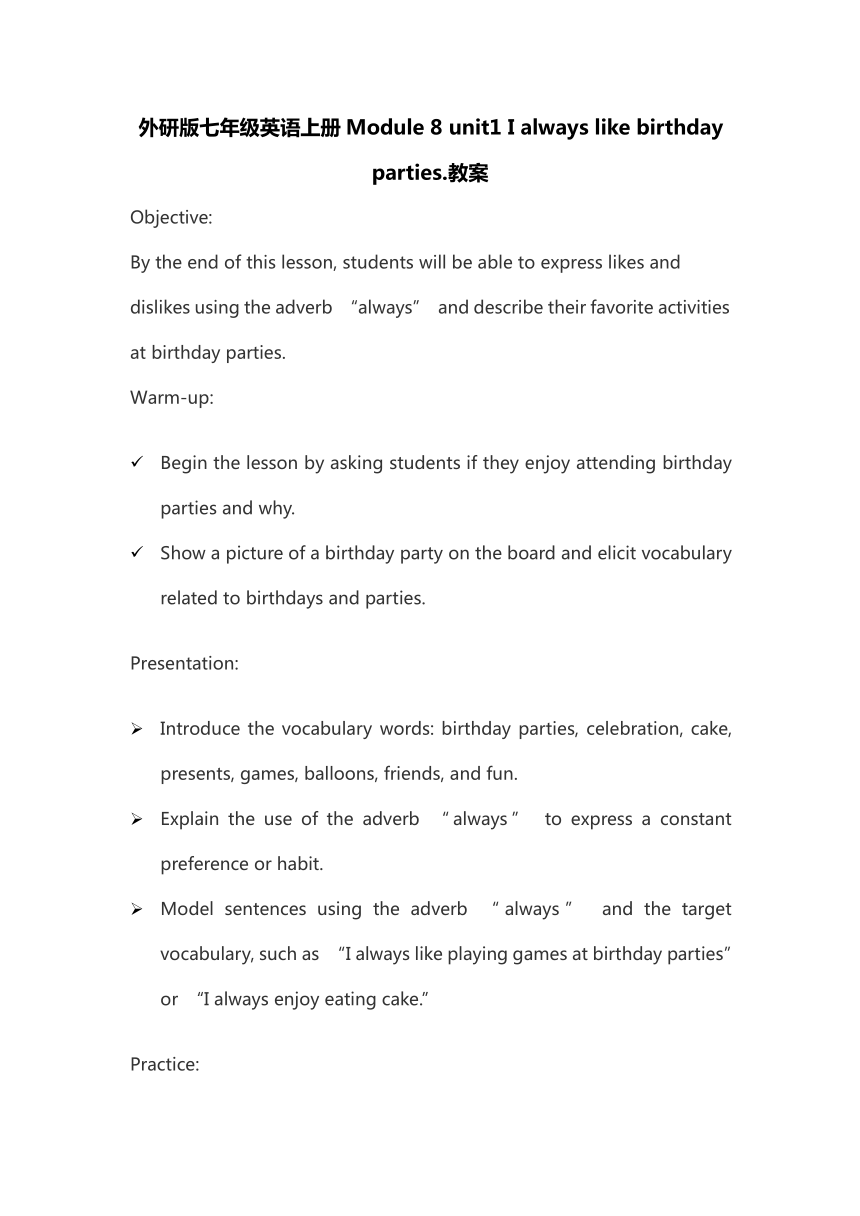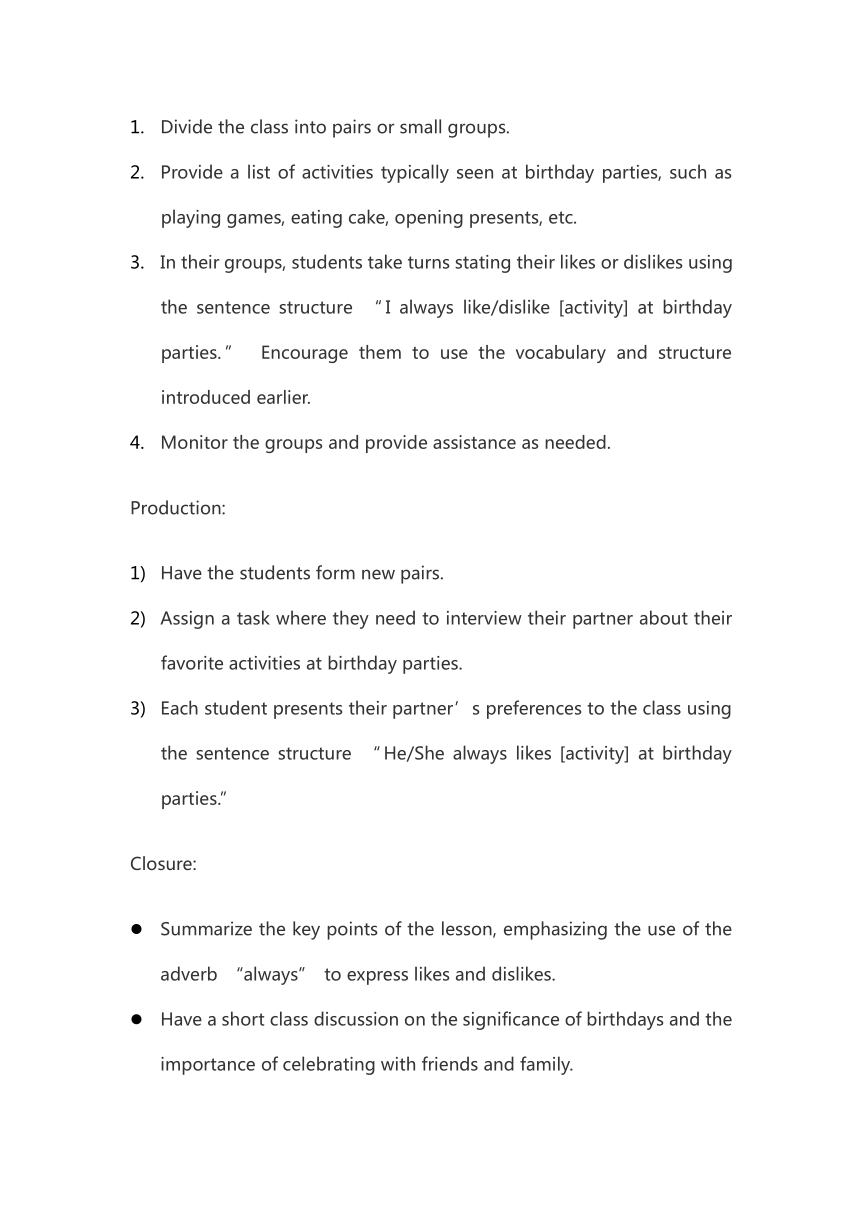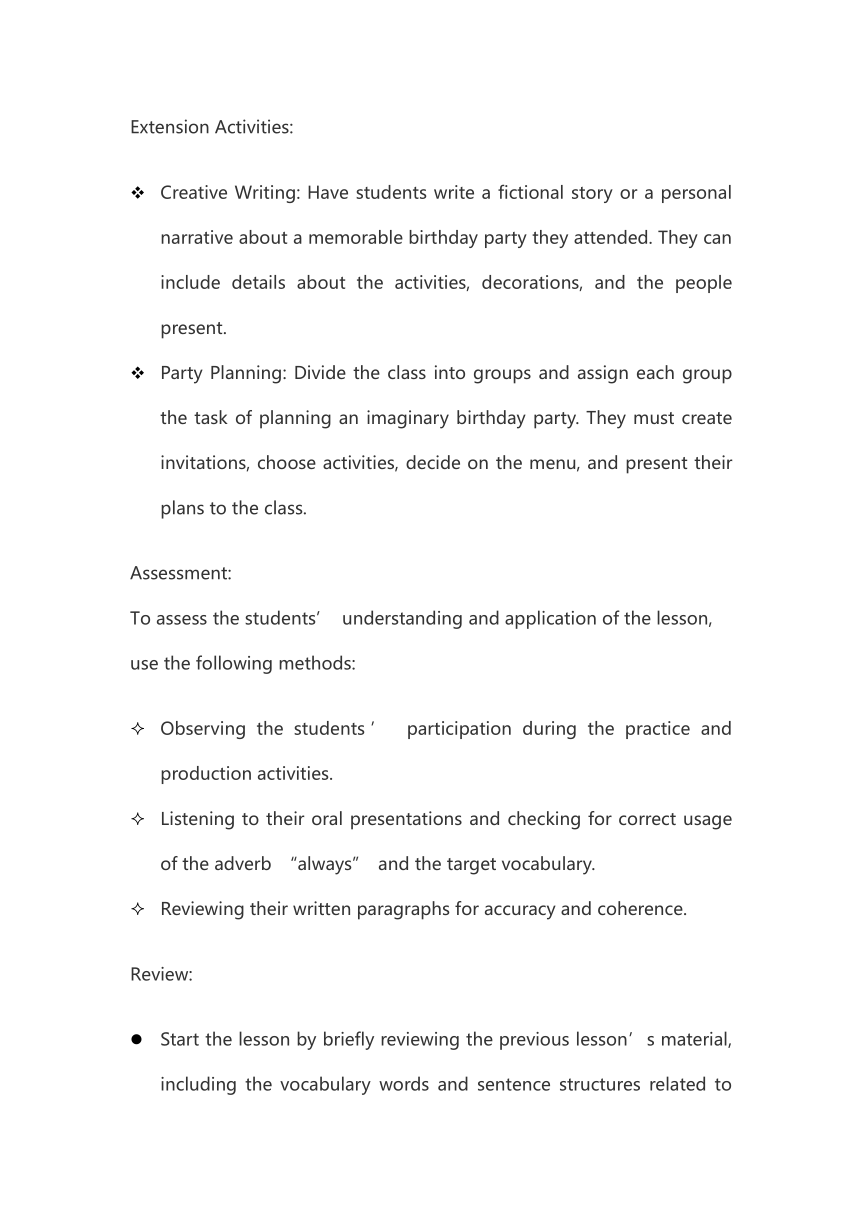Module 8 Unit 1 I always like birthday parties..教案
文档属性
| 名称 | Module 8 Unit 1 I always like birthday parties..教案 |  | |
| 格式 | docx | ||
| 文件大小 | 16.6KB | ||
| 资源类型 | 教案 | ||
| 版本资源 | 外研版 | ||
| 科目 | 英语 | ||
| 更新时间 | 2023-07-20 08:41:06 | ||
图片预览



文档简介
外研版七年级英语上册Module 8 unit1 I always like birthday parties.教案
Objective:
By the end of this lesson, students will be able to express likes and dislikes using the adverb “always” and describe their favorite activities at birthday parties.
Warm-up:
Begin the lesson by asking students if they enjoy attending birthday parties and why.
Show a picture of a birthday party on the board and elicit vocabulary related to birthdays and parties.
Presentation:
Introduce the vocabulary words: birthday parties, celebration, cake, presents, games, balloons, friends, and fun.
Explain the use of the adverb “always” to express a constant preference or habit.
Model sentences using the adverb “always” and the target vocabulary, such as “I always like playing games at birthday parties” or “I always enjoy eating cake.”
Practice:
Divide the class into pairs or small groups.
Provide a list of activities typically seen at birthday parties, such as playing games, eating cake, opening presents, etc.
In their groups, students take turns stating their likes or dislikes using the sentence structure “I always like/dislike [activity] at birthday parties.” Encourage them to use the vocabulary and structure introduced earlier.
Monitor the groups and provide assistance as needed.
Production:
Have the students form new pairs.
Assign a task where they need to interview their partner about their favorite activities at birthday parties.
Each student presents their partner’s preferences to the class using the sentence structure “He/She always likes [activity] at birthday parties.”
Closure:
Summarize the key points of the lesson, emphasizing the use of the adverb “always” to express likes and dislikes.
Have a short class discussion on the significance of birthdays and the importance of celebrating with friends and family.
Extension Activities:
Creative Writing: Have students write a fictional story or a personal narrative about a memorable birthday party they attended. They can include details about the activities, decorations, and the people present.
Party Planning: Divide the class into groups and assign each group the task of planning an imaginary birthday party. They must create invitations, choose activities, decide on the menu, and present their plans to the class.
Assessment:
To assess the students’ understanding and application of the lesson, use the following methods:
Observing the students’ participation during the practice and production activities.
Listening to their oral presentations and checking for correct usage of the adverb “always” and the target vocabulary.
Reviewing their written paragraphs for accuracy and coherence.
Review:
Start the lesson by briefly reviewing the previous lesson’s material, including the vocabulary words and sentence structures related to birthdays and parties. Use flashcards or a quick oral quiz to assess their understanding.
Introduction to Unit 1:
Introduce Unit 1 of Module 8, which focuses on birthday parties and celebrations.
Show the cover page of the Unit or display a relevant image to generate interest and curiosity among the students.
Provide a brief overview of the unit’s objectives and topics that will be covered.
Vocabulary Expansion:
Expand the students’ vocabulary related to birthday parties by introducing additional words or phrases. Examples include decorations, candles, singing, dancing, laughter, and surprises. Use visual aids, real objects, or gestures to help convey the meanings.
Practice the new vocabulary words through various activities such as matching games, vocabulary drills, or describing pictures with the new words.
Listening Skills:
Play a short audio clip or video that features native English speakers talking about their favorite activities at birthday parties. Ensure the content is appropriate for 7th-grade students and aligns with the language objectives.
Provide comprehension questions related to the audio/video, encouraging students to listen for specific details or preferences expressed.
Speaking Activity:
Divide the class into pairs or small groups.
Assign each group a scenario related to a birthday party, such as planning a surprise party, organizing a themed party, or creating a birthday party invitation. Alternatively, they can discuss their favorite birthday party memories.
Students take turns discussing and exchanging ideas within their groups while using the target vocabulary and sentence structures.
Monitor the groups, providing support, and offering language assistance as needed.
Select a representative from each group to share their ideas and experiences with the whole class.
Reading and Writing Practice:
Distribute a short reading passage about a fictional birthday party or a real-life birthday celebration.
Encourage students to read the passage individually or in pairs.
Discuss the main ideas, key details, and any unfamiliar vocabulary encountered in the text.
Ask students to write a paragraph describing their own memorable birthday party or an ideal birthday celebration. They should incorporate the target vocabulary and sentence structure in their writing.
Provide feedback on their writing, focusing on language accuracy, organization, and creativity.
Conclusion and Reflection:
Wrap up the lesson by reviewing the key vocabulary, sentence structures, and concepts covered.
Engage the students in a brief reflection activity, asking questions like “What did you learn about birthday parties today ” or “What was the most interesting activity for you ”
Address any remaining questions or concerns the students may have related to the topic.
Homework:
Assign a homework task related to the lesson, such as writing a birthday party invitation using the target vocabulary and sentence structures or researching the traditions of birthday celebrations in another culture and presenting their findings in the next class.
Objective:
By the end of this lesson, students will be able to express likes and dislikes using the adverb “always” and describe their favorite activities at birthday parties.
Warm-up:
Begin the lesson by asking students if they enjoy attending birthday parties and why.
Show a picture of a birthday party on the board and elicit vocabulary related to birthdays and parties.
Presentation:
Introduce the vocabulary words: birthday parties, celebration, cake, presents, games, balloons, friends, and fun.
Explain the use of the adverb “always” to express a constant preference or habit.
Model sentences using the adverb “always” and the target vocabulary, such as “I always like playing games at birthday parties” or “I always enjoy eating cake.”
Practice:
Divide the class into pairs or small groups.
Provide a list of activities typically seen at birthday parties, such as playing games, eating cake, opening presents, etc.
In their groups, students take turns stating their likes or dislikes using the sentence structure “I always like/dislike [activity] at birthday parties.” Encourage them to use the vocabulary and structure introduced earlier.
Monitor the groups and provide assistance as needed.
Production:
Have the students form new pairs.
Assign a task where they need to interview their partner about their favorite activities at birthday parties.
Each student presents their partner’s preferences to the class using the sentence structure “He/She always likes [activity] at birthday parties.”
Closure:
Summarize the key points of the lesson, emphasizing the use of the adverb “always” to express likes and dislikes.
Have a short class discussion on the significance of birthdays and the importance of celebrating with friends and family.
Extension Activities:
Creative Writing: Have students write a fictional story or a personal narrative about a memorable birthday party they attended. They can include details about the activities, decorations, and the people present.
Party Planning: Divide the class into groups and assign each group the task of planning an imaginary birthday party. They must create invitations, choose activities, decide on the menu, and present their plans to the class.
Assessment:
To assess the students’ understanding and application of the lesson, use the following methods:
Observing the students’ participation during the practice and production activities.
Listening to their oral presentations and checking for correct usage of the adverb “always” and the target vocabulary.
Reviewing their written paragraphs for accuracy and coherence.
Review:
Start the lesson by briefly reviewing the previous lesson’s material, including the vocabulary words and sentence structures related to birthdays and parties. Use flashcards or a quick oral quiz to assess their understanding.
Introduction to Unit 1:
Introduce Unit 1 of Module 8, which focuses on birthday parties and celebrations.
Show the cover page of the Unit or display a relevant image to generate interest and curiosity among the students.
Provide a brief overview of the unit’s objectives and topics that will be covered.
Vocabulary Expansion:
Expand the students’ vocabulary related to birthday parties by introducing additional words or phrases. Examples include decorations, candles, singing, dancing, laughter, and surprises. Use visual aids, real objects, or gestures to help convey the meanings.
Practice the new vocabulary words through various activities such as matching games, vocabulary drills, or describing pictures with the new words.
Listening Skills:
Play a short audio clip or video that features native English speakers talking about their favorite activities at birthday parties. Ensure the content is appropriate for 7th-grade students and aligns with the language objectives.
Provide comprehension questions related to the audio/video, encouraging students to listen for specific details or preferences expressed.
Speaking Activity:
Divide the class into pairs or small groups.
Assign each group a scenario related to a birthday party, such as planning a surprise party, organizing a themed party, or creating a birthday party invitation. Alternatively, they can discuss their favorite birthday party memories.
Students take turns discussing and exchanging ideas within their groups while using the target vocabulary and sentence structures.
Monitor the groups, providing support, and offering language assistance as needed.
Select a representative from each group to share their ideas and experiences with the whole class.
Reading and Writing Practice:
Distribute a short reading passage about a fictional birthday party or a real-life birthday celebration.
Encourage students to read the passage individually or in pairs.
Discuss the main ideas, key details, and any unfamiliar vocabulary encountered in the text.
Ask students to write a paragraph describing their own memorable birthday party or an ideal birthday celebration. They should incorporate the target vocabulary and sentence structure in their writing.
Provide feedback on their writing, focusing on language accuracy, organization, and creativity.
Conclusion and Reflection:
Wrap up the lesson by reviewing the key vocabulary, sentence structures, and concepts covered.
Engage the students in a brief reflection activity, asking questions like “What did you learn about birthday parties today ” or “What was the most interesting activity for you ”
Address any remaining questions or concerns the students may have related to the topic.
Homework:
Assign a homework task related to the lesson, such as writing a birthday party invitation using the target vocabulary and sentence structures or researching the traditions of birthday celebrations in another culture and presenting their findings in the next class.
同课章节目录
- Starte
- Module 1 My teacher and my friends
- Module 2 My English lesson
- Module 3 My English book
- Module 4 My everyday life
- Module 1 My classmates
- Unit 1 Nice to meet you.
- Unit 2 I'm Wang Lingling and I'm thirteen years ol
- Unit 3 Language in use.
- Module 2 My family
- Unit 1 Is this your mum?
- Unit 2 These are my parents.
- Unit 3 Language in use.
- Module 3 My school
- Unit 1 There are thirty students in my class.
- Unit 2 The library is on the left of the playgroun
- Unit 3 Language in use.
- Module 4 Healthy food
- Unit 1 We've got lots of apples.
- Unit 2 Is your food and drink healthy?
- Unit 3 Language in use.
- Module 5 My school day
- Unit 1 I love history.
- Unit 2 We start work at nine o'clock.
- Unit 3 Language in use.
- Revision module A
- Module 6 A trip to the zoo
- Unit 1 Does it eat meat?
- Unit 2 The tiger lives in Asia.
- Unit 3 Language in use.
- Module 7 Computers
- Unit 1 How do I write my homework on the computer?
- Unit 2 When do you use a computer?
- Unit 3 Language in use.
- Module 8 Choosing presents
- Unit 1 I always like birthday parties.
- Unit 2 She often goes to concerts.
- Unit 3 Language in use.
- Module 9 People and places
- Unit 1 We're enjoying the school trip a lot.
- Unit 2 They're waiting for buses or trains.
- Unit 3 Language in use.
- Module 10 Spring Festival
- Unit 1 Are you getting ready for Spring Festival?
- Unit 2 My mother's cleaning our houses and sweepin
- Unit 3 Language in use.
- Revision module B
